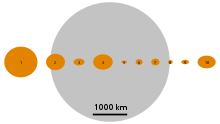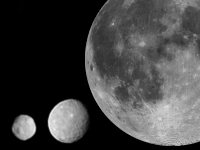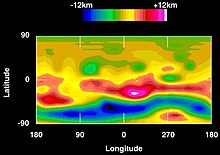(4) Vesta
(4) Vesta (Latin: Vesta) is the second most massive object in the asteroid belt and the third largest, with a main diameter of about 530 kilometers and an estimated mass of 9% of the entire asteroid belt. Vesta lost about 1% of its mass in an impact that occurred just under a billion years ago. Many fragments of this impact have collided with Earth, constituting a rich source of information about the asteroid. Vesta is the brightest asteroid and the only one sometimes visible to the naked eye as a 6th magnitude asteroid. The farthest point in its orbit from the Sun is not much larger than the closest point to the sun in Ceres's orbit.
Discovery
Vesta was discovered on March 29, 1807 from Bremen by the German physician and physicist Heinrich Wilhelm Olbers, whose hobbies led him to study the orbits of comets (in fact, he discovered five comets, in addition to the asteroids Vesta and Pallas). Olbers named the asteroid after Vesta, the virgin Roman goddess of the hearth, at the suggestion of mathematician Carl Friedrich Gauss.
After the discovery of Vesta in 1807, it took another 38 years to find a new asteroid, (5) Astraea. During this time, the four known asteroids were counted as planets and each had its own planetary symbol. Vesta was normally represented by the stylized form of an altar with its sacred flame (![]() ). It is a simplification of the old symbol
). It is a simplification of the old symbol ![]() . The original symbol of Gauss was
. The original symbol of Gauss was ![]() .
.
Physical characteristics
Vesta is the second most massive body in the asteroid belt (9%) and the densest of the asteroids. Scientists believe this body has a distinctly layered interior, with an iron-nickel core and an olivine-rich mantle. It is in the Main Inner Belt, which lies within the Kirkwood Hollows at 2.50 AU. It is similar to (2) Shovels in volume, but significantly more massive.
Vesta's shape is relatively close to a gravitationally relaxed oblate spheroid, but the large concavity and bulge at the pole preclude it from being considered a planet under IAU Resolution XXVI 5. In any case, this resolution was rejected by the members of the IAU and Vesta will continue to be considered an asteroid. However, it is possible that Vesta could be classified as a dwarf planet in the future, if it is convincingly determined that its shape, apart from its basin of massive impacts at the south pole, is due to hydrostatic equilibrium. "I don't think Vesta should be called an asteroid," says Tom McCord, a Dawn project associate researcher at the Bear Fight Institute in Winthrop, Washington. "Vesta is not only much larger, but it is also an evolved object, unlike most of what we call asteroids."
Its rotation is relatively fast for an asteroid (5.342 h) and prograde, with the north pole pointing in the direction of right ascension 20 h 32 min, declination +48 ° with an uncertainty of about 10th. This gives an obliquity of the ecliptic of 29°.
Surface temperatures have been estimated to be around -20°C with the Sun overhead, dropping to -190°C at the winter pole. Typical day and night temperatures are –60 °C and –130 °C, respectively. This estimate is from May 6, 1996, very close to perihelion, while the details vary somewhat between seasons.
Orbit
Vesta orbits the Sun between Mars and Jupiter, within the asteroid belt, with a period of 3.6 Earth years, specifically in the inner asteroid belt, within the Kirkwood Hollows at 2.50 AU. Its orbit is moderately inclined (i = 7.1°, compared to 7° for Mercury and 17° for Pluto) and with moderate orbital eccentricity (e = 0 0.09, coinciding with the value of 0.09 for Mars).
True orbital resonance phenomena between asteroids are considered unlikely, due to their small masses relative to their large distances, so such relationships should be very rare. However, Vesta is capable of capturing other asteroids in relationships 1:1 temporary resonant orbitals (for periods of up to 2 million years or more). About forty objects have been identified in this situation. The decameter-sized objects detected in the vicinity of Vesta by Dawn may be more quasi-satellites than proper satellites.
Coordinate Systems
There are two coordinate systems in use for Vesta, with their respective reference meridians separated by 150°. The International Astronomical Union established a coordinate system in 1997 based on Hubble photographs, with the prime meridian passing through the center of Olbers Regio, a dark area 200 km in diameter. When the Dawn probe arrived at Vesta, mission scientists found that the IAU assumed pole location was offset by 10°, so the IAU coordinate system was shifted across Vesta's surface at the rate of 0.06° per year. Olbers Regio is not discernible up close, and therefore was not adequate to define the prime meridian with the necessary precision. The pole was corrected, but a new principal meridian was also established at 4° degrees from the center of Claudia, a clearly defined crater 700 meters in diameter, which allows improving the results of cartographic data collection. All the publications of NASA, including images and maps of Vesta, use the Claudian meridian, which has not been accepted by the IAU. In turn, the UAI Working Group on Cartographic Coordinates and Rotational Elements recommended its own coordinate system, correcting the pole but rotating the Claudian longitude by 150° to make the reference meridian coincide with Olbers Regio. This system was accepted by the IAU, although it disrupts the maps prepared by the Dawn team, which had been configured so that none of Vesta's major surface features lay in different planes.
Studies on Vesta
Vesta's layered structure (core, mantle, crust) is the key feature that makes Vesta more like planets like Earth, Venus, and Mars than other asteroids. Like the planets, Vesta contained enough radioactive material in its interior when it formed from the collision and melting of fragments. This released enough heat to melt the rock and allow the lighter layers to float to the surface. Scientists call this process 'differentiation'.
In the early days of the solar system, Vesta was hot enough that its interior melted. This caused their differentiation from asteroids. It likely has a layered structure: a metallic iron-nickel core surrounded by a mantle of olivine. The surface is basaltic rock formed from ancient volcanic eruptions; obviously there was some kind of brief volcanic activity. This makes Vesta different from other asteroids and in a sense brings it closer to terrestrial planets, which underwent similar geological processes.
It wasn't the only one of its kind, however: probably dozens of large planetoids originally existed, but all the rest were smashed to pieces during the early days of chaos, forming families of smaller asteroids. Metallic iron-nickel asteroids are thought to come from the cores of these large bodies, while rocky ones come from their mantles and crusts.
Not even Vesta has remained intact. In 1996 the Hubble Space Telescope detected a huge crater on Vesta, 430 km in size and perhaps 1 billion years old. It is believed that this crater may be the origin of the small V-type asteroids or Vestoids that are known today.
In 2001 it was determined that one of these asteroids called (1929) Kollaa was not only a piece of Vesta, but also that the exact place of its formation was the deep part of the crust.
The Yarkovsky effect along with disturbance from planets and asteroids causes the Vesta family to scatter. Some of these asteroids, such as (9969) Braille, have become near-Earth asteroids. Smaller fragments have rained down like meteorites. Vesta is believed to be the origin of HED meteorites.
The Institute of Space and Astronautical Science (ISAS) reported that its researchers had found water on Vesta after making observations with the UKIRT 3.8m Infrared Telescope in March 2003. the "surface hydrated or hydroxylated minerals" are believed to come from carbonate chondrite asteroid impacts rather than from Vesta itself.
Our knowledge of Vesta is expected to grow tremendously after the Dawn space probe entered orbit around the asteroid in August 2011, where it will remain until May 2012.
Geology
There is a large collection of samples accessible to potential scientists, in the form of more than 200 HED meteorites, giving insight into Vesta's geological history and structure.
(4) Vesta is believed to have a metallic iron-nickel core; higher up, a rocky layer of olivine and finally a crust. Since the first appearance of inclusions rich in Calcium and Aluminum (the first solid matter in the solar system, formed about 4567 million years ago). A possible timeline of Vesta's geology is as follows:
- Acreation ends after about 2-3 million years.
- Complete or Almost. the merger is completed due to the radioactive disintegration of the Al 26which leads to the separation of basic metals in about 4-5 million years.
- Progressive crystallization of a melted and connective mantle. Convection stops when about 80% has crystallized, in approximately 6-7 million years.
- The extrusion of the remaining molten material to form the cortex. Each basal lava in progressive eruptions or possibly forming an ocean of short-lived magma.
- The deepest layers of the crystallized bark to form pneumonic rocks, while the old basalts are metamorphized due to the pressure of the new layers of surface.
- Slow cooling of the interior.
Vesta is the only known intact asteroid to have been resurfaced in this way. However, the presence of iron and achondrite meteorites with no identified parents indicates that there were once other distinct planetesimals with igneous histories, which have been shattered by impacts.
Vesta's crust has been reasoned to consist of (in order of increasing depth):
- A regolito litificate, the source of howarditas and breccied eucritas.
- The basaltic lava that flows, the source of non- cumulative eucritas.
- Plutonic rocks consisting of piroxeno, pygyonite and plagioclase, the source of cumulative eucritas.
- Plutonous rocks rich in orthopiroxeno with large granulated portions, the source of diogenites.
Based on the sizes of V-type asteroids (thought to be pieces of Vesta's crust ejected during large impacts) and the depth of the south pole crater, the crust is thought to be about 10 km thick.
Surface characteristics
Some surface features on Vesta have been resolved using the Hubble Space Telescope and other ground-based telescopes such as the Keck Telescope.
The most prominent surface feature is a huge 460 km diameter crater centered near the South Pole which has been named Rheasilvia. Its width is 80% of the entire diameter of Vesta. The floor of this crater is about 13 km and its rim appears 4-12 km above the surrounding terrain, with an estimated total area of about 25 km. A central peak appears about 18 km up from the crater floor. The responsible impact is estimated to have excavated approximately 1% of the entire volume of Vesta and it is likely that the Vesta family of asteroids and V-type asteroids are products of this collision. If this is the case, then the fact that 10 km of fragments of the Vesta family of asteroids and V-type asteroids have survived the bombardment to the present indicates that the crater is only 1 billion years old or younger. It would also be the area of origin of the HED meteorites. In fact, all V-type asteroids taken together are only 6% of the ejected volume, the rest are presumably small fragments, ejected by roughly a 3:1 ratio Kirkwood holes or perturbed by the Yarkovsky effect or pressure from radiation. Spectroscopic analyzes of Hubble Space Telescope images have shown that this crater has penetrated deep through distinct crustal layers and possibly into the mantle as indicated by olivine spectral signatures. Interestingly Vesta was not disrupted or resurfaced by an impact of this magnitude.
Other large craters about 150 km wide and 7 km deep are also present. A characteristic dark albedo of about 200 km has been named Olbers after the discoverer of Vesta, but it does not appear on elevation maps as a crater and its nature remains unknown, perhaps an ancient surface basaltic. It serves as a longitude reference point (zero meridian) defined as the one that passes through its center.
The eastern and western hemispheres show considerably different terrain. From preliminary spectral analyzes of Hubble Space Telescope images, the eastern hemisphere appears to have some form of high albedo, with large crater-top terrain of regolithic age and the investigated craters in deeper plutonic layers of the crust. On the other hand, large regions of the Western Hemisphere are assumed to be dark geologic units thought to be basalt-surfaced, perhaps analogous to the lunar Mar.
Snippets
Several small objects in the solar system are believed to be fragments of Vesta caused by collisions. Vesta family asteroids and HED meteorites are examples of these. The V-type asteroid (1929) Kollaa has been determined to have a composition similar to cumulative Eucrites, indicating its origin deep within the crust of Vesta.
Because several meteorites are thought to be fragments of Vesta, Vesta is currently one of only five identified solar system bodies with physical fragments. The others are Mars, the Moon, comet 81P/Wild, and Earth itself.
Vesta Exploration
NASA's Dawn space probe was launched on September 27, 2007 and is the first space mission to Vesta. It orbited the asteroid for nine months, from August 2011 to May 2012. Dawn then moved on to its other target in 2015, Ceres, and will continue to explore the asteroid belt on an extended mission using all remaining fuel. The spacecraft is the first to be able to go in and out of orbit around more than one body, thanks to its efficient ion propulsion engines.
In 2006 NASA tried to cancel Dawn, citing budgetary pressures and technical issues, but scientists appealed and an additional $100 million was added to continue the program. The total cost of the mission will be about $450 million.
In the 14 months that Dawn has been orbiting Vesta, it has been able to map the asteroid's surface. From the information obtained through these maps, it has been determined that two large meteoritic impact events took place, called Veneneia and Rheasilvia, which initially shaped the appearance of Vesta. However, another large event later, called Marcia, shaped the asteroid to its current configuration.
Visibility
Its size and unusually bright surface make Vesta the brightest asteroid, and it is occasionally visible to the human eye in dark, unpolluted skies. As recently as May and June 2007, Vesta peaked at magnitude +5.4, the brightest since 1989.
At the time, opposition and perihelion were only a few weeks away. It was visible in the constellations Ophiuchus and Scorpius.
Less favorable oppositions have been had during late autumn in Vesta's northern hemisphere at a magnitude of about +7.0.
Even when conjunct the Sun, Vesta will have a magnitude of about +8.5, so in a pollution-free sky it can be observed with binoculars even at much smaller elongations than the near opposition.
Contenido relacionado
(162) Laurentia
(20) Massalia
(10) Hygiene







